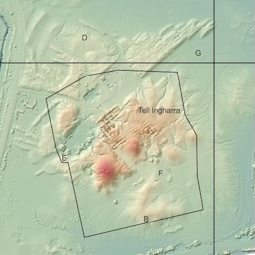Tell Ingharra (east Kish, ancient Hursagkalama)
The ancient city of Hursagkalama was Kish's twin city. It was an important religious centre in itself (Moorey 1978: 178-9). We know its name thanks to cuneiform tablets discovered on Mound W. Like Kish opposite, we do not know how large Hursagkalama was, but its imposing earthen buildings are all across the site. For example a Sumerian palace was built on Mound A in the third millennium BC, close to Hursagkalama's two ziggurats, while the monumental temple of Ishtar was built in the first millennium BC. Next to these enormous structures, archaeologists have found the remains of many more ordinary buildings, the former homes and shops of the people of Kish, and perhaps even traces of a school or scholars' house (Mound W).
 [/kish/images/sbah-ingharra-large.jpg]
[/kish/images/sbah-ingharra-large.jpg]Map of Tell Ingharra with location markings, May 2024. Source: State Board of Antiquities and Heritage, Iraq
A cuneiform text from Nineveh, which records city names and their associated constellations, tells us that Hursagkalama was associated with the Wolf constellation (Steele 2015: 208). The Wolf is visible in the southern hemisphere, and if you are ever able to visit Hursagkalama after nightfall, you might be able to see it. Kish has a long relationship with the night sky: the names of the earliest kings of Kish given in the Sumerian King List are the names of constellations (Dalley 2023: 33; Frayne 2008: 50-51).
Tell Ingharra includes the following excavation sites today:
- The Temple of Ishtar (Mound E)
- The two ziggurats on Tell Ingharra (Mounds B and F)
- The Sumerian Palace (Mound A)
- The Chariot Burials (Trench Y)
- Babylonian Home Schooling at Tell Ingharra (Trench C)
- Sassanian Villas or Palaces (Mounds G-H)
15 Sep 2025
Nadia Aït Saïd-Ghanem
Nadia Aït Saïd-Ghanem, 'Tell Ingharra (east Kish, ancient Hursagkalama)', The Forgotten City of Kish • مدينة كيش المنسية, The Kish Project, 2025 [http://oracc.org/MoundsofKish/TellIngharra/]